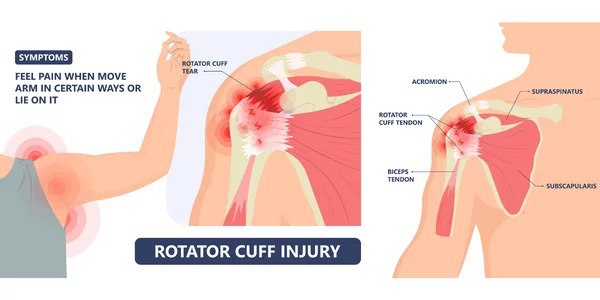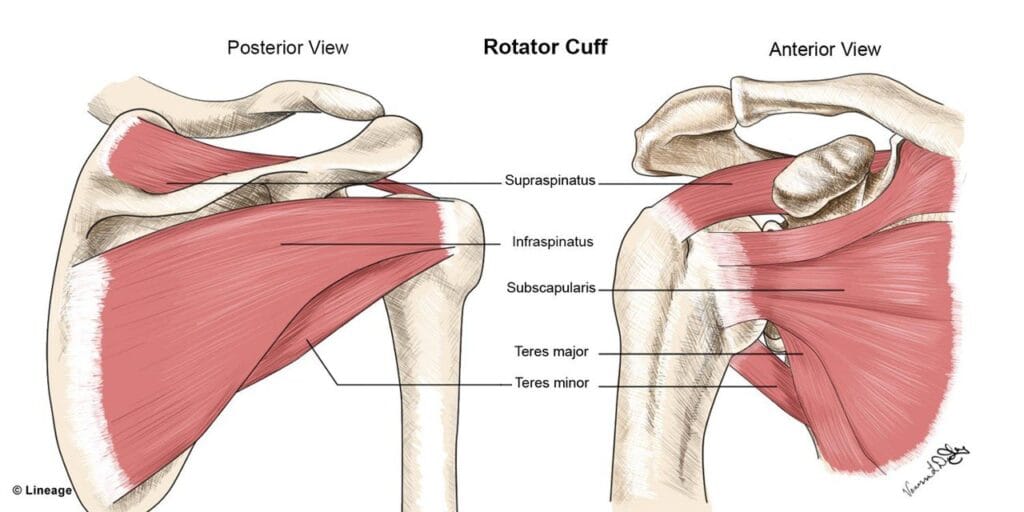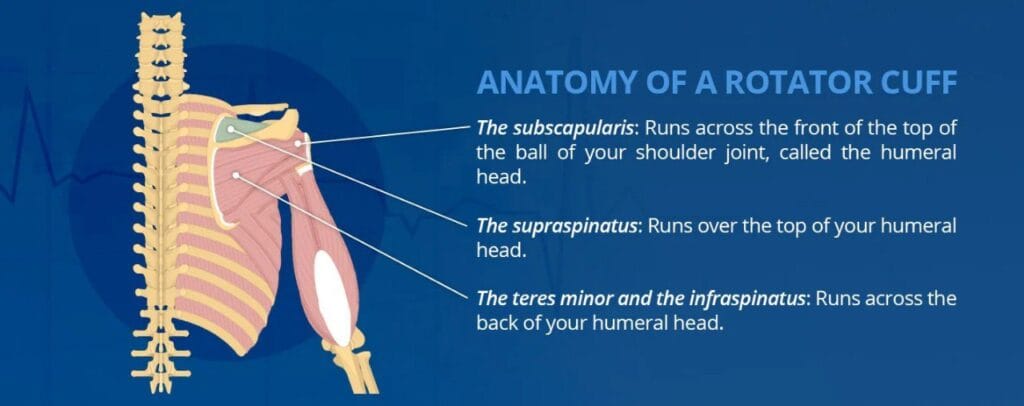In this concluding piece of his complex trauma series, Professor Mohamed Imam, a highly experienced consultant orthopaedic surgeon, sheds light on rotator cuff tears, offering insights into their causes, symptoms, treatment options, and strategies for managing symptoms and enhancing function post-injury.
The rotator cuff comprises crucial muscles and tendons within the shoulder joint, essential for arm mobility and stability in the shoulder. Comprising four muscles – the supraspinatus, infraspinatus, teres minor, and subscapularis – the rotator cuff works synergistically to enable various shoulder motions, including lifting, rotating, and reaching.
Despite its relatively small size, the rotator cuff is instrumental in ensuring smooth and coordinated movement of the shoulder joint.
This intricate structure is prone to injury and degenerative changes, leading to a range of debilitating conditions such as rotator cuff tears, tendonitis, and impingement syndrome.
I ) What causes rotator cuff tears and how does it impact vulnerability?
Understanding the Causes and Vulnerability of Rotator Cuff Tears
Rotator cuff tears can arise from various factors, including gradual wear and tear and sudden traumatic events. One primary contributor to rotator cuff tears is the natural ageing process, which weakens the tendons over time, making them more susceptible to injury.
Repetitive shoulder movements, such as lifting heavy objects and participating in sports like baseball or swimming, can gradually wear down the rotator cuff tissues, increasing the likelihood of tears.
These repetitive stresses accumulate over time, especially in occupations or activities that involve frequent overhead motions.
Acute trauma from falls, accidents, or forceful impacts can cause immediate tears in the rotator cuff. Such injuries can occur unexpectedly and are often associated with activities like motor vehicle accidents or sports-related collisions.
Individual factors such as age, overall shoulder health, and level of physical activity can influence the vulnerability to rotator cuff tears.
Older individuals or those with pre-existing shoulder conditions may be at a higher risk, mainly if they engage in activities that place additional strain on the shoulder joint.
Recognizing these risk factors early on and implementing preventive measures can reduce susceptibility to rotator cuff tears and preserve shoulder function.
- II) What are the symptoms of rotator cuff tears, and why is early detection critical?
Identifying the Symptoms of Rotator Cuff Tears and the Importance of Early Detection:
Pain:
Rotator cuff tears often manifest as persistent shoulder pain, particularly when engaging in overhead movements or lifting objects. This discomfort may intensify during nighttime, especially when lying on the affected shoulder. The pain could significantly impact daily activities and diminish overall quality of life.
Weakness:
A notable symptom of rotator cuff tears is weakness in the affected shoulder. This weakness can hinder basic tasks like lifting objects or reaching behind the back. The diminished strength compromises functional abilities and may lead to further limitations in daily functioning.
Limited Range of Motion:
Individuals with rotator cuff tears commonly experience a decease range of motion in the shoulder joint.
This limitation makes it challenging to perform activities that require entire shoulder movement, such as reaching overhead or behind the body. The restricted range of motion affects overall mobility and may impede participation in various physical activities.
Crepitus:
Some individuals may notice a sensation of popping or crackling in the shoulder joint, called crepitus when moving the arm.
This auditory or tactile feedback can be unsettling and may accompany other symptoms of rotator cuff tears.
Muscle Atrophy:
In more severe rotator cuff tears, muscle atrophy or the loss of muscle mass in the shoulder region may occur over time. Reduced use and mobility of the affected shoulder contribute to muscle weakness and wasting.
Muscle atrophy further compromises shoulder function and may necessitate additional interventions to address the loss of tissue integrity and strength.
Early detection of rotator cuff tears is critical for several reasons:
Preventing Further Damage:
Early identification of rotator cuff tears is crucial in preventing the tear from worsening and causing additional damage to the shoulder joint. Prompt diagnosis allows for timely intervention and implementation of treatment strategies aimed at stabilising the tear and promoting optimal healing. By addressing the tear early on, individuals can minimise the risk of further structural compromise and deterioration of shoulder function.
Minimising Pain and Discomfort:
Timely detection of rotator cuff tears enables individuals to receive appropriate pain management strategies tailored to their specific needs. Effective pain management not only alleviates discomfort but also enhances the quality of life by improving sleep, mood, and daily functioning.
Early intervention allows for the implementation of targeted pain relief measures, such as medication, physiotherapy modalities, and lifestyle modifications, to address symptoms and promote comfort during the healing process.
Preserving Shoulder Function:
Early treatment interventions, including physical therapy and targeted exercises, play a critical role in preserving shoulder function and mobility following a rotator cuff tear.
By initiating rehabilitative care promptly, individuals can prevent muscle atrophy, joint stiffness, and loss of range of motion, thereby maximising functional outcomes and restoring shoulder integrity.
physiotherapy focuses on strengthening the surrounding musculature, improving joint stability, and promoting proper biomechanics to facilitate optimal recovery and enhance overall shoulder function.
Avoiding Complications:
Left untreated, rotator cuff tears can lead to various complications, including shoulder instability, chronic pain, and loss of function. Early detection and intervention are essential in minimising the risk of complications and optimising long-term outcomes.
By addressing the tear promptly, individuals can mitigate the progression of degenerative changes, reduce the likelihood of secondary injuries, and improve overall shoulder health.
Early management also allows for the implementation of preventive measures to mitigate potential complications, such as postural corrections, activity modifications, and ongoing monitoring to ensure optimal healing and functional restoration.
III ) What are the most effective treatments for rotator cuff tears, and how can individuals choose the right option for their needs?
Exploring Treatment Options for Rotator Cuff Tears:
Non-Invasive Approaches:
Physiotherapy: Structured physical therapy programs developed by experienced physical therapists focus on strengthening the shoulder muscles, improving the range of motion, and alleviating discomfort associated with rotator cuff tears.
Customised exercises are designed according to each person’s specific requirements and involve stretching, strength-building activities, and hands-on therapeutic methods to improve shoulder mobility and facilitate healing.
Pain Management: Over-the-counter medications, such as acetaminophen or non-steroidal anti-inflammatory drugs (NSAIDs), can help reduce inflammation and alleviate pain with rotator cuff tears.
Corticosteroid injections :
In many instances, they are often suggested as a temporary solution to alleviate pain and inflammation. These injections are typically reserved for cases where other conservative measures have failed to provide relief, as they may have potential side effects such as tendon weakening.
Rest and Activity Modification:
Allowing the affected shoulder to rest and avoiding activities that exacerbate symptoms are essential to the non-invasive management of rotator cuff tears.
Resting the shoulder helps reduce inflammation and irritation of the injured tendon, facilitating healing.
Activity modification may involve avoiding overhead movements or repetitive motions that strain the shoulder, allowing the tendon to heal without further stress.
Surgical Solutions:
Arthroscopic Repair:
Arthroscopic rotator cuff repair is a less invasive surgical procedure that involves repairing the torn tendon using small incisions or a tiny camera called an arthroscope.
This technique allows for a more precise tendon repair while minimising damage to surrounding tissues.
Arthroscopic repair is associated with faster recovery times, reduced postoperative pain, and improved functional outcomes compared to traditional open surgery.
Open Repair:
Open surgical repair may be necessary in cases of extensive or complex rotator cuff tears.
This procedure involves making a bigger incision to access and repair the damaged tendon directly.
Open repair may be preferred in cases where the tear is large, retracted, or associated with other shoulder pathologies that require additional surgical intervention.
Tendon Transfer:
In cases where the rotator cuff tendon is irreparable or severely damaged, tendon transfer surgery may be considered.
This procedure involves transferring a healthy tendon from another body part, such as the latissimus dorsi or the pectoralis major, to replace the damaged rotator cuff tendon.
Tendon transfer surgery is typically reserved for cases where other surgical options are not feasible and aims to restore shoulder stability and function.
IV ) How can individuals best manage symptoms and enhance function after a rotator cuff tear?
Selecting the Appropriate Treatment:
- Consultation with Healthcare Provider:
Seeking advice from a qualified healthcare provider, such as an orthopaedic surgeon or sports medicine specialist,It’s essential to identify the most appropriate treatment considering individual factors such as the severity of the tear.
- Lifestyle and Activity Consideration:
Age, occupation, and recreational activities should be considered when deciding on a treatment approach. Individuals with physically demanding jobs and active lifestyles may benefit more from surgical intervention.
- Shared Decision-Making:
Collaborative decision-making between the individual and their healthcare provider ensures that the chosen treatment aligns with the individual’s goals, preferences, and expectations for recovery.
The success of treating rotator cuff tears depends on factors such as the severity of the tear, personal health considerations, and individual preferences. Consulting with a healthcare provider and considering lifestyle and activity levels can help individuals choose the most suitable treatment option aligned with their recovery objectives.



